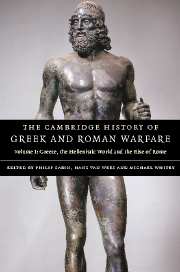Book contents
- Frontmatter
- Introduction: The Historiography of Ancient Warfare
- Part I Archaic and Classical Greece
- 4 International relations
- 5 Military forces
- 6 War
- 7 Battle
- 8 Warfare and the state
- 9 War and society
- Part II The Hellenistic World and the Roman Republic
- Chronological Table
- Glossary
- List of Ancient Authors
- Bibliography
- Index of ancient passages cited
- General index
- Map 1 The western Mediterranean
- Map 3 The Near East
- References
5 - Military forces
from Part I - Archaic and Classical Greece
Published online by Cambridge University Press: 28 March 2008
- Frontmatter
- Introduction: The Historiography of Ancient Warfare
- Part I Archaic and Classical Greece
- 4 International relations
- 5 Military forces
- 6 War
- 7 Battle
- 8 Warfare and the state
- 9 War and society
- Part II The Hellenistic World and the Roman Republic
- Chronological Table
- Glossary
- List of Ancient Authors
- Bibliography
- Index of ancient passages cited
- General index
- Map 1 The western Mediterranean
- Map 3 The Near East
- References
Summary
introduction
In a passage extolling the virtues of order the fourth-century historian and former general Xenophon waxes eloquent on the beauty of a well-organized army.
An orderly army elates its watching supporters, but strikes gloom into its enemies. I mean, who – if he is on the same side – could fail to be delighted at the sight of massed hoplites marching in formation, or to admire cavalry riding in ranks? And who – if he is on the other side – could fail to be terrified at the sight of hoplites, cavalry, peltasts, archers, slingers all arranged and following their commanders in a disciplined way?
As we can see from Xenophon’s list, hoplites were the most conspicuous and usually the most important Greek troops, followed by the four other major types of land troops in descending order of status: cavalry, peltasts (light-armed spearmen), archers and slingers. Most scholars argue that the basic trend in military forces from the early archaic period through the classical period was the establishment and then the decline of hoplite primacy. According to this model, hoplite supremacy was established in the early seventh century. All cities that wanted to win land battles had to man large hoplite armies and fight it out on the small agricultural plains of Greece. Light-armed troops and cavalry were of minimal significance. The late fifth and the fourth centuries saw the dominance of hoplites challenged as their vulnerabilities and the advantages of mixed armies became obvious. It is for this reason that Victor Hanson entitled a chapter on fourth-century warfare, ‘Hoplites as dinosaurs’.
Keywords
- Type
- Chapter
- Information
- The Cambridge History of Greek and Roman Warfare , pp. 108 - 146Publisher: Cambridge University PressPrint publication year: 2007
References
- 10
- Cited by

